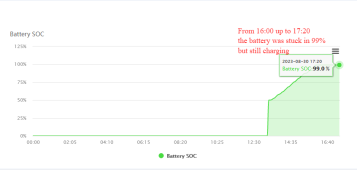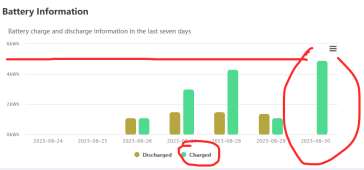Hello everyone!
I recently bought a 51.2V / 150Ah LiFePo4 battery from a certain seller on aliexpress, with numerous positive reviews (not fake).
The battery looks very well made and my first tests were positive, the battery communicates perfectly with my inverter (Growatt SPF5000ES) and in general it looks like a quality item. Please note that i have set the battery as Li in the inverter and communication is normal and successful.
I have not installed my solar panels yet, so i tried to test charge the battery from utility.
I started from 50% SOC. When the battery arrived at 99% (154.8Ah) it was stuck there and remained at this percentage for more than half an hour! Charging current was 30A (0.2c) all the way from 50% SOC. At some point the current dropped to 18A and then to 7A. It eventually reached 100%SOC but that was more than 1hour AFTER it reached 99% SOC! So i have spent around 5kWh in total to go from 50% SOC up to 100% SOC.... This is not normal, don't you think? For a battery with a theoretical capacity of 7.68kWh....
Maybe you could help me on this? Is this normal? Is it normal for a LiFePo4 battery to delay so much to reach 100% SOC?
I recently bought a 51.2V / 150Ah LiFePo4 battery from a certain seller on aliexpress, with numerous positive reviews (not fake).
The battery looks very well made and my first tests were positive, the battery communicates perfectly with my inverter (Growatt SPF5000ES) and in general it looks like a quality item. Please note that i have set the battery as Li in the inverter and communication is normal and successful.
I have not installed my solar panels yet, so i tried to test charge the battery from utility.
I started from 50% SOC. When the battery arrived at 99% (154.8Ah) it was stuck there and remained at this percentage for more than half an hour! Charging current was 30A (0.2c) all the way from 50% SOC. At some point the current dropped to 18A and then to 7A. It eventually reached 100%SOC but that was more than 1hour AFTER it reached 99% SOC! So i have spent around 5kWh in total to go from 50% SOC up to 100% SOC.... This is not normal, don't you think? For a battery with a theoretical capacity of 7.68kWh....
Maybe you could help me on this? Is this normal? Is it normal for a LiFePo4 battery to delay so much to reach 100% SOC?
Attachments
Last edited:






